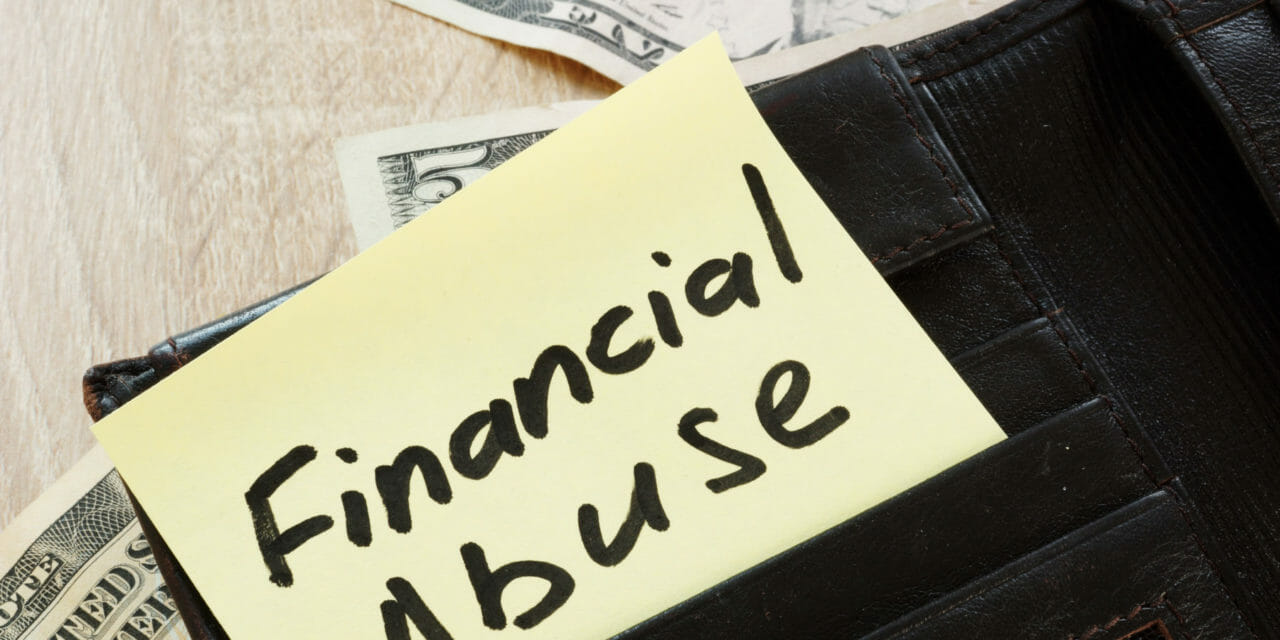When you think of domestic abuse, physical or verbal assault are probably the first things that come to mind. Unfortunately, financial abuse is often overlooked, even though it occurs in 99 percent of all domestic violence cases. The effects of financial abuse can last for years or even decades after victims escape abusive relationships.
“The devastating impact of financial abuse lasts longer than other areas of harm from an abusive relationship,” explains Shannon Thomas, Licensed Clinical Social Worker who has conducted extensive research on financial abuse. “It undermines the survivor’s ability to navigate through life in every way.”
Financial abuse can take on many forms. Some abusers use manipulation to covertly remain in control of a victim’s finances while others resort to outright intimidation or threatening behavior. No matter how financial abuse presents itself in a relationship, it can make it extremely difficult for victims to escape, and once they do escape, they are often forced to start rebuilding their financial independence from scratch.
Starting over financially
The first step is always escaping the abusive situation, but what comes next? While this next chapter can feel overwhelming, this is ultimately an opportunity for you to lay a strong foundation on which to build the rest of your life. Here are steps you can take to establish your financial independence and help ensure long-term financial health.
Open new accounts
Some survivors may have done this back when they were planning their escape, but anyone who hasn’t should make it a first priority. Choose a reputable bank that fits your needs. Some offer budgeting help if you need it. Others offer online banking options that help customers manage their finances online. Larger chain banks typically offer a wider range of services while smaller local banks offer a personal touch to the banking process.
Do some online research, talk to friends or family for recommendations and make an informed decision based on what you feel will be right for you.
Opening an account is typically a simple process. You’ll need your Social Security Number and a valid ID. Some banks require minimum deposits for opening certain types of accounts. If you have enough money for the minimum deposit on a savings account, it’s a good idea to open both a checking and savings account.
Make a budget
Once you have separate accounts set up, the next step is to make a budget that you can stick to. Rachel Cruze, personal finance expert and daughter of Dave Ramsey, said it best, “A monthly budget gives you permission to spend money where you want.” By taking the time and effort to budget out your expenses, you make it easier for you to justify spending money on certain things.
The bottom line is that you shouldn’t spend more than you make each month. There is no such thing as a one size fits all budget. You have to figure out what works best for you and your financial goals. There are a lot of different techniques for budgeting that fit different lifestyles.
50/30/20
Some experts recommend the 50/30/20 budget, which is a method that separates your take-home pay into three different buckets: needs, wants and savings. “Needs” are considered expenses like rent, transportation, water, nutrition and other bills – this should take up 50 percent of your income. “Wants” are expenses like going out with friends, shopping and entertainment – this should take up 30 percent of your budget. The other 20 percent should be put towards savings and other financial goals such as getting out of debt or investing.
80/20
A simpler version of the 50/30/20 method is the 80/20 budget, which just has you take 20 percent of your income to put towards savings and freely spend the rest. Depending on how aggressive you want to be with your savings, you can change up the percentage that you want to set aside.
This probably isn’t the best technique for a beginner, but once you have a handle on your spending habits, this is an option you can move towards to simplify the budgeting process.
Envelope method
If fractions aren’t really your thing, there is also a technique called the envelope method. Label envelopes with certain expense categories. You can choose a simple categorization method – wants, need, savings – or something more intricate – rent, utilities, groceries, eating out, entertainment, savings. The idea is to physically set aside the money you will spend in each category.
Budgeting apps
There is an app for just about everything, and budgeting is no exception. If you have a smartphone or tablet, you can connect your bank accounts and credit cards to one of the many apps that will help budgeting. Mint is a crowd favorite, allowing users to track bills, create budgets, and manage pretty much all aspects of your personal finances. You Need A Budget (otherwise known as YNAB) is another popular app that you can use to help create budgets and stay accountable.
Start building credit
Your credit report determines how trustworthy you are in the eyes of lenders. Without a good credit score, you could be denied for personal loans, mortgages, vehicle financing and more. Even if you are approved, many lenders give unfavorable interest rates and terms to borrowers with lower credit scores.
The easiest way to start building credit is to apply for a credit card and make timely monthly payments. For first-time credit card users, here are a few things to consider when researching which credit card will work best for you:
APR – The higher the APR, the more interest and fees you’ll have to pay on purchases when you don’t pay your bill in full each month. With a low credit score (or no credit score at all), you’re more likely to qualify for higher interest credit cards, but you can utilize 0% interest credit cards that offer an introductory period with no interest to pay off larger purchases. Just make sure to pay off the debt before the intro period ends.
Secured credit cards – Secured cards require a deposit that acts as your line of credit. For example, if you put $250 down as the deposit, that will act as your credit limit on the card. This is a solid option for those truly starting from scratch with zero credit history. After a year of responsible spending and paying off your balance on time each month, many issuers will return the deposit.
Authorized users – Sometimes, the best first step to building credit is to become an authorized user on a friend or family member’s account. If they have a good credit score and healthy spending habits, that will look good on your credit report. Just make sure that you are in agreement on how much you are allowed to spend each month and how you plan on paying them for those purchases.
Once you have a credit card, it’s important to establish healthy credit habits early on. Don’t spend more than you can pay off at the end of each month, always pay your bill on time and check your credit report for inaccuracies regularly.
Make saving a habit
Unexpected expenses happen – they’re part of life. Make it a priority to start saving a little of every paycheck in case of financial emergencies. Not having the money to cover unexpected expenses can have a lasting impact on your finances and cause you to go into debt. You should aim to have at least three to six months’ worth of essential expenses. Once you have that saved, you should consider putting money aside for other financial goals (such as a vacation fund, money to go back to school or the deposit on a house) or investing for retirement.
Resources to help you rebuild
You don’t have to go through this process alone. Surround yourself with friends and family who you can trust, and don’t be afraid or ashamed to ask for help when you need it. There are also local and national programs available to help get you back on your feet.
Local food banks
In the first few months after escaping, it can feel impossible to even put food on the table. There are local food banks throughout America that help feed individuals and families. You can Google local food banks in your area or check out Feeding America’s search tool.
Government assistance
Federal benefit programs can help you get back on your feet after escaping an abusive situation. There are programs available to help qualifying families and individuals pay for groceries, healthcare, housing and more. Some programs, such as Temporary Assistance for Needy Families (TANF), also offer non-cash benefits like childcare and job training.
Domestic abuse coalitions
Many states have coalitions against domestic violence. These organizations can offer assistance to survivors looking for help getting back into the workforce, connecting with other survivors, finding support groups and more. You can check out The National Domestic Violence Hotline for a list of national and state-level organizations.
Getting back into the workforce
For some survivors of financial abuse, leaving is the first time in a long time that they’ve been job hunting or working. It can be discouraging when you can’t find a job right away or when you’re at an entry-level job in a field you once held a higher position. Remember that this is just a starting point, and there are resources and organizations that can help you get back into the workforce.
Master the side hustle
If you’re looking for some extra cash to balance out your budget or help save up for financial goals, try taking up a side hustle. This is a great way to make new connections, add some experience to your resumé and learn a new skill – all while making more money.
Freelance websites like Upwork and Fiverr match employers with freelancers with certain skills. You can write technical articles, take care of secretarial work and just about everything in between. If you enjoy crafting unique or handmade goods, you can sell your items on Ebay or Etsy to make some extra cash. Being a part-time driver for companies like DoorDash, GrubHub or Lyft is another option.
Never give up
“Rebuilding after financial restoration after abuse must be viewed as a marathon and not a sprint,” says Thomas. “Every step towards financial stability post abuse should be recognized and celebrated. Otherwise, the rebuilding process can become discouraging.”
This chapter in your life can be exhausting and exhilarating and just about every emotion in between. The important thing is to never give up. Working to establish and maintain your financial health is a lifelong journey, but these steps and tips can help you start the process.
If you or a loved one is suffering from domestic abuse (including financial abuse), please reach out for help. You can contact the National Domestic Violence Hotline at 1-800-799-SAFE.







